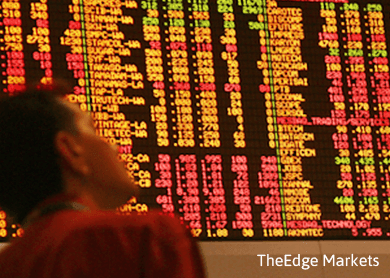
THE market was bearish in the past week as the FBM KLCI was unable to hold above the long-term 200-day moving average. The index broke below the average last week and remained below it.
Market confidence was marred by a weaker ringgit and mixed global markets performances. The KLCI declined 1.6% in a week to 1,798.61 points.
The trading volume was firm and relatively low in the past week compared with the previous week. The average daily trading volume in the past week was only 1.7 billion shares.
The average daily trading value declined marginally from RM2 billion two weeks ago to RM1.9 billion in the past week.
Foreign institutions continued to exit from the market last week. From last Tuesday to last Friday, net buying from local institutions was RM453.8 million.
Foreign institutions’ net selling was RM460.4 million. In the KLCI, only two out of 30 counters gained from last week.
The two gainers in the KLCI were Malayan Banking Bhd (+0.3% from last week) and CIMB Group Holdings Bhd (+0.2%).
The top three decliners in the index were MISC Bhd (-6.6%), Kuala Lumpur Kepong Bhd (-4.5%) and IOI Corp Bhd (-3.3%).
Performances of global markets were mixed. China’s Shanghai Stock Exchange Composite Index rebounded and closed 2.4% higher in a week to 4,401.98 points. Hong Kong’s Hang Seng Index fell 1.2% to 27,407.18 points. Japan’s Nikkei 225 Index increased only 0.4% to 19,624.84 points, and Singapore’s Straits Times Index declined 0.8% to 3,442.33 points.
The US dollar marginally weakened against major currencies, but Wall Street rose slightly higher. The US Dow Jones Industrial Average increased only 0.2% in a week to 18,105.17 points on Monday, after pulling back from a two-month high last Friday.
Germany’s DAX Index increased only 0.5% to 11,673.35 points and London’s FTSE100 increased 0.6% to 7,025.78 points. However, at the time of writing when Bursa Malaysia closed, Germany’s DAX and London’s FTSE100 were down at 11,405 points and 6,910 points respectively.
The US dollar index declined from 95.2 last week to 94.4 points yesterday evening. Despite the weaker dollar index, the ringgit weakened against the US dollar from RM3.58 per US dollar to RM3.61.
In the major commodities market, Commodity Exchange gold declined only 0.4% in a week to US$1,183 an ounce. WTI crude oil lost its bullish momentum and closed marginally higher from last week at US$59.40 per barrel.
Crude palm oil in Bursa continued to rally from the rebound two weeks ago on stronger demand. The price increased 3.1% in a week to RM2,224 per tonne.
After breaking below the short-term 30-day moving average two weeks ago, the KLCI fell below the long-term 200-day moving average.
By definition alone, the KLCI is technically bearish. The index even fell into the Ichimoku Cloud indicator and the index will be below it if it falls below 1,790 points. A breakout below this level could spell rainy days for Bursa.
Momentum indicators like the RSI, Momentum Oscillator and MACD continued to decline with no indication of a rebound. The next support level can only be found at 1,775 points.
Furthermore, the index is trading at the bottom band of the expanding Bollinger Bands indicator. This indicates that the bearish momentum is strong.
With immediate support levels being violated and the bearish momentum strengthening, we expect further downside for the market if the KLCI does not manage to climb above the long-term 200-day moving average at 1,816 points.
The next support level to be tested is at 1,775 points and if there is no support at this level, the index may fall back to this year’s low at 1,700 points.
Benny Lee is chief market strategist for Jupiter Securities Sdn Bhd. Jupiter Securities is a participating broker in Bursa Malaysia. He can be contacted at [email protected]. The views expressed in the article are the opinions of the writer and should not be construed as investment advice. Please exercise your own judgement or seek professional advice for your investment decisions.
This article first appeared in The Edge Financial Daily, on May 13, 2015.